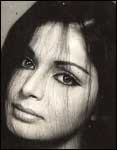
HOME | MOVIES | FEEDBACK |

Raakhee is born August 15, Independence Day. That might count for why this light-eyed and beauteous Bengali actress has always exhibited a strongly independent streak in the manner in which she steered the course of her life and career.
She had the courage to walk out of a go-nowhere marriage at 18, and carve a place for herself in the film industry. When she felt her second marriage too was not working, she decided to live life on her own terms, returned to films and became a successful star all over again.
Raakhee had to learn to be self-reliant at a very young age. She was born in a big family just outside Kolkata. After her father suffered losses in his business, a young Raakhee went to live with actress Sandhya Roy. While still in her teens, Raakhee had an ill-starred marriage to filmmaker Ajay Biswas.
After winning raves for her breakthrough Bengali film, Badhu Baran (1967), Raakhee caught the Rajshri banner's attention and its head honcho Tarachand Barjatya gave her a dream break with Jeevan Mrityu (1970). She was paired opposite an A-list star Dharmendra. Armed with doe-eyed innocence and innate charm, Raakhee played a young girl led to believe that she is a widow. Incidentally, Rajshris released her debut film in limited shows and hit pay dirt with this marketing formula that they reprised later in Hum Aapke Hain Koun...?.
Within a year, Raakhee swept into the critics' vision like a desert storm with Sunil Dutt's sand-and-vendetta drama, Reshma Aur Shera. She had only a cameo but left a lasting impression with her electrifying and justifiably much-touted scene as the bride who finds out she is widowed soon after marriage and breaks down completely.
Still in the nascent stages of her career, Raakhee played a double role in Sharmilee (1971) and doubled producer Subodh Mukherjee's investments too. Cast opposite a suave Shashi Kapoor, Raakhee played twin sisters --- a vampish, smoking-drinking libertine and a traditional, demure, domesticated devi --- with judiciously-administered sass and sucrose.
Raakhee had her share of indifferent films (Wafaa, Shehzaada, Yaar Mera) in this stage of her career, and even appeared in as many as ten movies in 1972. She was often cast as a glamour doll, but her histrionic adeptness was never in doubt, whether it was a commercial film like Blackmail or a defiantly unconventional foray into art cinema like the acclaimed 27 Down. There was both frost as well as fire in those exquisite honey-coloured eyes.
The actress got involved with the established writer and budding director Gulzar and in 1973, she wrapped up her assignments and plunged into marriage. She won Best Supporting Actress Award for playing Yash Chopra's original Chandni in the marital mix-up, Daag (1973), but she was busy concentrating on her pregnancy. The arrival of her beloved daughter Bosky marked a major landmark in Raakhee's life.
But by the mid-1970s, Raakhee and Gulzar had separated; and Raakhee returned to the film industry.
Time became a valuable commodity as Raakhee reached the creative acme of her career after her comeback. Her first two films after her return --- Rajshri's Tapasya (1975) and Yash Chopra's Kabhie Kabhie (1976) were both huge hits.
Tapasya gave Raakhee the tragedienne tag (she played self-sacrificing elder sister to a brood of siblings) and invited comparisons to Meena Kumari. That is because Raakhee learnt to modulate her voice into a husky, emotionally effective timbre. And Kabhie Kabhie, in which the Chopra spared no effort to make her look stunning, started a long association with Amitabh Bachchan.
Raakhee next came up with a trio of hits with Bachchan in one year (1978) --- Trishul, Kasme Vaade and Muqaddar Ka Sikander. Despite the Bachchan aura, Raakhee was that rare actress who would manage decent roles in his films, especially in the movies directed by Hrishikesh Mukherji (Jurmana and Bemisaal).
While the Bachchan films sustained her saleability, Raakhee, ever the strong-headed actress, kept her creative fires burning by boldly taking on an elder woman's role opposite Rishi Kapoor in Doosra Aadmi (1977), at the height of her success. In an undervalued performance, Raakhee played a emotionally unfulfilled woman's who succumbs to an attraction towards a younger man (Rishi Kapoor) who reminds her of her dead lover (Shashi Kapoor).
Clad mostly in saris now, Raakhee gained weight and began to look matronly by the early eighties, but still succeeded in author-backed roles like Basera and Shraddhanjali (both 1981).
After playing Amitabh's sweetheart in eight films, Raakhee went ahead and defiantly played his mother in Ramesh Sippy's Shakti (1982). Incidentally, their romantic film Bemisaal was released the same year. For Raakhee, it was not commercial consideration, but character that was paramount.
In 1985, Raakhee gave a standout performance in Aparna Sen's Paroma as the middle-aged housewife whose contact with a young male photographer makes her question her familiar but cloistered world.
Subsequently, Raakhee became famous as the formidable doyenne of films like Dacait (1987), Ram Lakhan (1989), Saugandh (1991), Anadi (1993) and Karan Arjun (1995), who could be relied on to give barbed portraits of wronged and vengeful motherhood. Nineties' films like Khalnayak, Baazigar and Border showcased her softer side, but she was still all-too-often misty-eyed.
The grand dame of Hindi films still holds the reins of her life determinedly in her own hands --- consenting to do the odd film when it is associated with an Amitabh Bachchan (Ek Rishta) or a Rituparno Ghosh (Shubho Muharat), dabbling with her farm, doting on her daughter and living a single life in her Mumbai bungalow, Muktangan.
|
|||||||||
(c) 1996 - 2002 rediff.com India Limited. All Rights Reserved. |
||||||||||